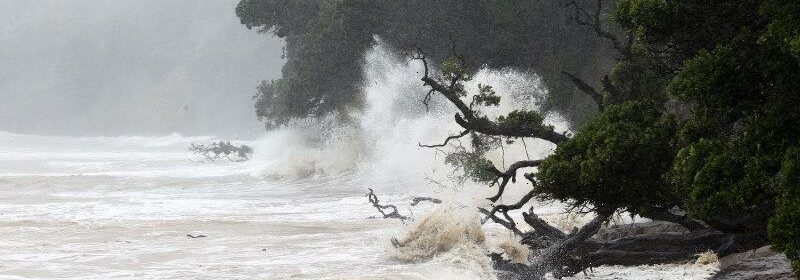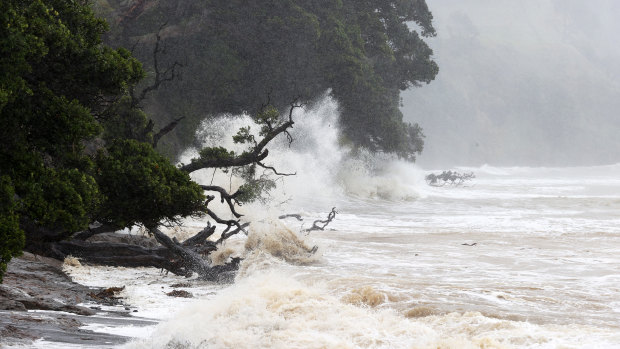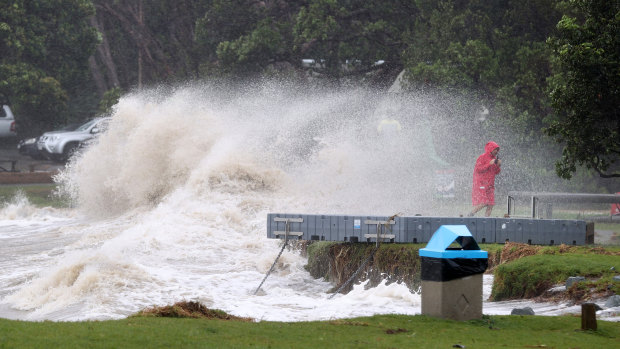‘Roofs lifting off homes’: People evacuated as Cyclone Gabrielle lashes New Zealand

New Zealand could be plunged into a state of emergency after Cyclone Gabrielle left tens of thousands of homes without power with the worst still to come as the storm surged south.
First identified in the Coral Sea last week, Cyclone Gabrielle has travelled across the South Pacific to sit about 200 kilometres northeast of Auckland and is forecast to move close to the east coast in the next 24 hours.
Huge waves from the effects of Cyclone Gabrielle on the Goat Island Marine Reserve.Credit:Getty Images
The cyclone passed over the Australian territory of Norfolk Island on Saturday night as a category-two storm with gusts of up to 155km/h.
As it nears landfall in New Zealand, NZ meteorological agency MetService reported gusts of 163km/h at Channel Island, near the Coromandel Peninsula, on Monday morning.
In Auckland, where the worst of the weather is likely still to come, gusts have peaked at 133km/h on the northern beaches.
MetService has issued dozens of warnings across the country, including several red alerts, which it saves for only the most destructive weather.
Prime Minister Chris Hipkins urged New Zealanders to avoid non-essential travel and bunker down.
Cyclone Gabrielle is already causing widespread damage in seven regions in New Zealand.Credit:Getty Images
“Things are likely to get worse before they get better with more rain and severe winds forecast,” he said.
Mr Hipkins said conditions had not yet met the threshold for a national state of emergency, which has been declared just twice in New Zealand previously – for the 2011 Christchurch earthquakes and the COVID-19 pandemic.
Key officials are meeting every four hours to consider the declaration.
At least seven regions – Northland, Auckland, Waikato, Hauraki, Coromandel, Opotiki and Tairawhiti – had declared local emergencies by Monday afternoon.
In Auckland, the local emergency has been maintained since January 27, when New Zealand’s biggest city endured its biggest 24-hour rainfall on record – 245mm.
The deluge brought widespread flooding, rendered hundreds of homes uninhabitable and killed four people.
With the clean-up unfinished, and other 150-250mm of rain forecast across the next three days, fears are held for more flooding and slips that could wipe out infrastructure and homes.
Elsewhere in New Zealand, localised reports of damage are streaming in.
All major roads in the Coromandel and Tairawhiti regions have been blocked due to slips or tree falls, with some localities receiving more than 100mm of rain before noon on Monday.
Homes were evacuated in Whakatane, Onepoto, Tolaga Bay and Whangarei, which received 184mm of rain in the 24 hours to 9am on Monday.
One man is feared dead after a report of a missing boat near Great Barrier Island, with a search deemed unsafe in hazardous conditions.
Emergency management officials confirmed 58,000 people were without power due to damaging winds, most in Northland.
Emergency services attended more than 220 wind-related call outs overnight.
“Roofs lifting off homes. Windows blown out. A couple of places where trees have fallen on houses. Lots of fallen trees on roads and bringing down powerlines,” Fire and Emergency NZ spokesman Vaughan Mackereth said.
Air New Zealand cancelled all flights in and out of Auckland and a string of regional airports on Monday, with 45,000 customers.
Auckland ferries, trains and many inter-city buses were also cancelled.
Cook Strait ferries were cancelled in advance as bad weather tracks further south on Tuesday when the capital Wellington will encounter severe gales.
Cyclone Gabrielle’s effects are likely to be felt across New Zealand until Wednesday, with tracking maps suggesting the storm will continue south to the Coromandel before heading east over the Bay of Plenty and Tairawhiti.
AAP
Get a note directly from our foreign correspondents on what’s making headlines around the world. Sign up for the weekly What in the World newsletter here.
Most Viewed in World
From our partners
Source: Read Full Article

